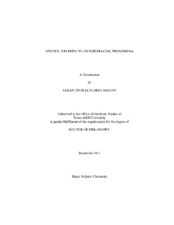| dc.description.abstract | A new interdisciplinary facet of chemistry has developed, as we attempt to comprehend complex interfacial phenomena in which ions play crucial roles. Understanding the mechanisms by which ions affect water at surfaces and interact with the molecules dissolved in it, pose a ubiquitous challenge with enormous implications for biological and physical sciences. These represent steps towards unraveling mechanisms in protein folding and crystallization, protein-protein interactions, enzymatic activity, implant biocompatibility, atmospheric chemistry phenomena, and even in more inorganic processes like metal oxide dissolution and corrosion; all of them fundamental technological challenges.
In this thesis, the specific ion effects on interfacial water structure adjacent to air/water and solid/water interfaces were explored using vibrational sum frequency spectroscopy. At the air/water interface, monolayers of bovine serum albumin, elastin-like peptides, and surfactants, were analyzed in presence of subphases that consisted of different sodium salts and varying pH value. The results suggested that anions interact directly with the protein?s surface, and their effects on water structure are dominated by the charge state of the interfacial layer, rather than the detailed chemical structure of the macromolecules. At the solid/liquid interface, water structure at surfaces like quartz, octadecyltrichlorosilane-covered quartz, and titanium oxide, confirmed that the propensities of anions to adsorb at an interface are favored for more polarizable anions, following the Hofmeister order, and disproving the notion that the order of the interaction can be inverted with changes in charge sign or degree of hydrophobicity of the surface.
Similarly, by analyzing interfacial water structure we performed one of the very first systematic studies on the interactions of cations with metal oxide surfaces. The results showed that specific cation effects were quite prominent at low concentration and high pH value, following a direct Hofmeister series, which can be explained in terms of charge density, polarizability, and basicity of the oxide surfaces.
Our findings are of interest, since they provide with essential information not only to understand protein phenomena associated with neurodegenerative conditions like Alzheimer, but also by proving the generality of ion interactions beyond biological, we can even influence the development of the next generations of microprocessors and beyond. | en |


